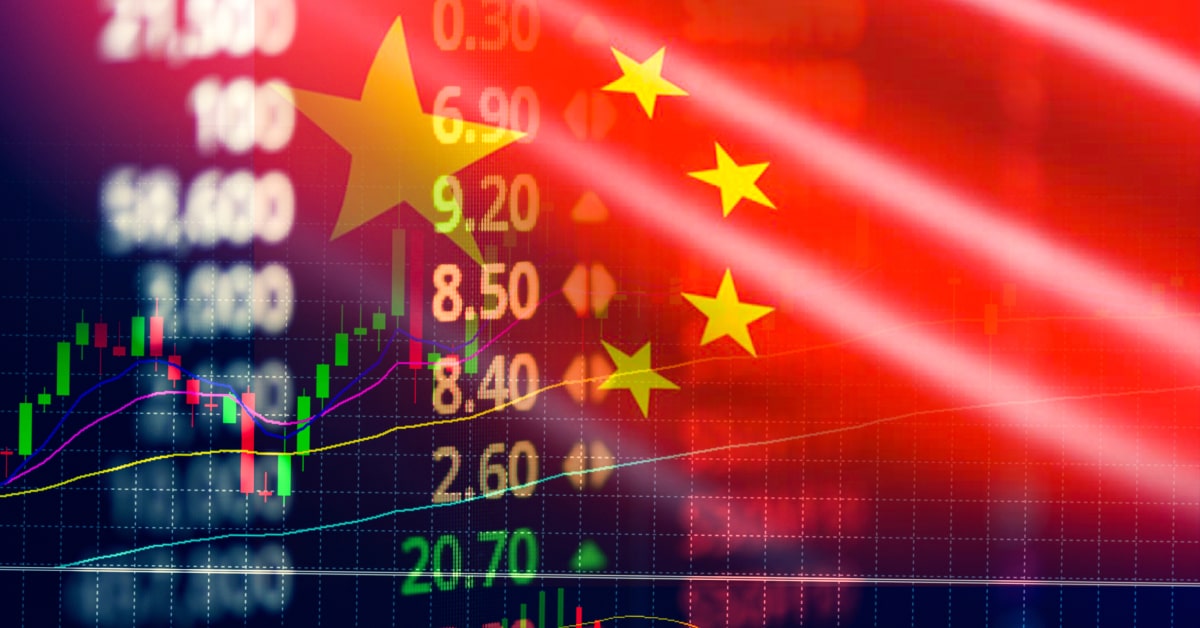Analysis
AI Renaissance RMB Expansion: The Dual Forces Driving Hang Seng’s Rally
.jpg)
Over the past few trading days, the Hang Seng Index has shown strong bullish momentum, fully recovered the mid-June losses and actively testing the local high of 24,300 points from June 11, reflecting steadily improving market sentiment.

This rebound is partly fueled by easing geopolitical tensions in the Middle East and a global risk-on sentiment recovery. Meanwhile, the US tariff suspension is nearing expiration with little progress in negotiations. Trump’s recent comments on the Fed raised concerns about its independence, while dovish signals within the FOMC have increased market expectations for rate cuts. Together, these factors have weakened the US dollar, providing additional support for Hong Kong stocks priced in HKD.
While these macro drivers have some influence, they tend to be short-term or spillover effects insufficient to sustain the Hang Seng’s upward trajectory. More important for investors is identifying the factors that could provide longer-lasting momentum for Hong Kong equities.
Beyond the rise of new consumption (Labubu deserves a dedicated article), I believe the resurgence of the AI narrative and China-Hong Kong’s policies on digital currency and stablecoin reform will be the two main themes driving the Hang Seng’s mid-term performance.
AI Reignites with China’s Cost-Effective Solutions
As market risk appetite returns, the Nasdaq recently hit new highs. Nvidia rose over 4% this week, AMD surged nearly 14%, and tech giants like Amazon, Meta, and Microsoft followed suit.

Yet as traders revive bullish bets on AI, questions resurface: Are US tech valuations too high? Is it still wise to chase the rally? Against this backdrop, Chinese tech stocks, offering better valuations and improving fundamentals, are gaining renewed global investor attention.
China’s AI sector developments reinforce this logic. Since the DeepSeek R1 model attracted attention, a “low-power, high-efficiency” domestic AI path has taken shape. Despite US GPU export controls, China’s AI progress continues with an improving domestic chip ecosystem—Huawei Ascend, Baidu Kunlun, Alibaba Hanguang all lowering training costs and boosting deployment efficiency.
On this foundation, Chinese AI companies are rapidly iterating. After DeepSeek R1, Minimax’s M1 model further enhanced inference performance, emerging as a dark horse. Zhipu, preparing for a Hong Kong IPO in April 2025, pursues a “tech export plus local private deployment” strategy across emerging markets and is seen as a potential OpenAI competitor. These firms leverage open-source communities, domestic chips, and engineering prowess to build “China solutions” tailored to local scenarios.
Alongside these newcomers, industry giants Tencent, Alibaba, Baidu, and ByteDance are accelerating AI asset integration and commercialization. China’s AI development now forms a full ecosystem—from foundational model research, compute infrastructure, toolchain construction to industry application.
Supporting this ecosystem is massive infrastructure and policy investment. China has built the world’s largest 5G network; intelligent computing capacity now accounts for 35%. Estimates suggest annual AI-related capital expenditure has reached RMB 400 billion. By 2035, AI data centers could consume 10% of national power, achieving full green energy adoption—providing physical backing for large model training and building lasting competitive barriers.
This evolving AI ecosystem fundamentally supports the investment logic for Hong Kong stocks. On one hand, Hong Kong tech stocks still have valuation repair potential, offering “low valuation, high leverage” opportunities. On the other, accelerating AI deployment in China boosts corporate fundamentals and invites global investors to reassess China’s role and pricing power in the global AI value chain.
RMB Internationalization Accelerates with Hong Kong as a Frontline Pilot
Beyond AI, last week’s Lujiazui Forum delivered important signals on digital RMB and RMB internationalization. Authorities proposed establishing a digital RMB international operation center, piloting offshore RMB bond issuance, launching RMB FX futures, and accelerating RMB going global to enhance pricing power.

The digital RMB itself bears no interest or fees, employs a “two-tier” system between central and commercial banks, ensuring state credit and improving payment efficiency. Unlike stablecoins issued by companies backed by assets and external regulation, digital RMB digitizes cash directly, enjoys legal tender status, and carries lower credit risk.
Currently, most cross-border clearing depends on SWIFT and CHIPS, unable to circumvent the US dollar system. China aims to build alternative channels via digital RMB and CIPS, with the core goal of reducing dollar reliance and enabling faster, cheaper, and more controllable RMB cross-border flows.
Notably, the pilot follows a “dual-track” approach: Mainland advances digital RMB, Hong Kong explores stablecoin regulation. This secures the main channel while creating a “testing ground” for innovation on payment efficiency, data supervision, and financial compliance, aiming to boost RMB influence.
Alongside digital RMB, other tools progress in tandem. The free trade zone’s “onshore-offshore bonds” simplify issuance, enhancing liquidity and operational flexibility. RMB FX futures offer mature hedging tools and pricing references for cross-border projects.
Though seemingly disparate, these moves form part of China’s broader effort to reshape its external financial system, accelerating implementation. For Hong Kong stocks, two impacts stand out:
First, Hong Kong as a frontline of RMB internationalization stands to benefit first from digital currency pilots, clearing system upgrades, and stablecoin oversight. Related sectors like fintech, banking, and trading platforms could directly gain from policy dividends.
Second, improved RMB cross-border channels will increase RMB asset accessibility and hedging capability, enhancing Hong Kong’s appeal in global asset allocation—especially for long-term capital seeking low-entry access to China’s market. Hong Kong is becoming the ideal gateway.
Is now the time to jump into the Hang Seng?
While AI and RMB internationalization offer solid mid-term tailwinds, the Hang Seng currently faces clear resistance around 24,300 points, with divided views on whether positive changes suffice to sustain gains. I remain cautiously bullish on Hong Kong stocks mid-term, but breaking key technical levels or challenging all-time highs will require more concrete catalysts.
Externally, US-China talks have shown goodwill but lack breakthroughs on critical areas like rare earths and chips. The market expects the White House to postpone the July 9 tariff decision to allow more negotiation time. Though China’s tariff exemptions last until August, the US’s broader trade stance hints at a more cautious policy tone, potentially recreating “TACO-style” trading patterns.
For Hong Kong stocks, short-term trade uncertainties persist. However, if tariff extensions materialize alongside softening US labor markets and easing inflation, rate cut expectations could rise, lifting risk appetite. Export-oriented firms await clearer policy signals, while Chinese tech and digital economy sectors—with valuation advantages and policy support—may lead the rebound. Current low valuations amid fragile confidence and fast theme rotation mean marginal improvements could have amplified effects.
On the domestic front, IPO and financing policies merit attention. In early June, regulators endorsed Guangdong-Hong Kong-Macau Greater Bay Area “dual listings,” allowing companies listed on the HKEX to apply for simultaneous listing on the Shenzhen exchange. This policy could unlock two-way capital flows and broaden funding channels beyond Hong Kong, attracting more mainland investors to quality tech firms.
Additionally, AI unicorn MiniMax is reportedly preparing for a Hong Kong IPO. Though early-stage, discussions on valuation and fundraising are underway. If successful, MiniMax could become the largest AI tech IPO in Hong Kong, materially boosting the sector’s valuation anchor and market interest.
In summary, rapid AI advancements and accelerating RMB internationalization are the two core forces driving the Hang Seng’s mid-term recovery. Despite short-term trade risks, China’s domestic AI solutions inject lasting confidence into the tech sector, while RMB cross-border payment and financial innovation further strengthen the investment case for Hong Kong stocks.
Starting in July, Pepperstone will add 26 selected Hong Kong stocks spanning technology, new consumption, and banking sectors—helping you ride the Hang Seng’s rally and seize the best entry opportunities.
The material provided here has not been prepared in accordance with legal requirements designed to promote the independence of investment research and as such is considered to be a marketing communication. Whilst it is not subject to any prohibition on dealing ahead of the dissemination of investment research we will not seek to take any advantage before providing it to our clients.
Pepperstone doesn’t represent that the material provided here is accurate, current or complete, and therefore shouldn’t be relied upon as such. The information, whether from a third party or not, isn’t to be considered as a recommendation; or an offer to buy or sell; or the solicitation of an offer to buy or sell any security, financial product or instrument; or to participate in any particular trading strategy. It does not take into account readers’ financial situation or investment objectives. We advise any readers of this content to seek their own advice. Without the approval of Pepperstone, reproduction or redistribution of this information isn’t permitted.